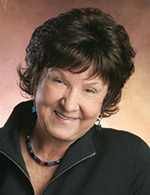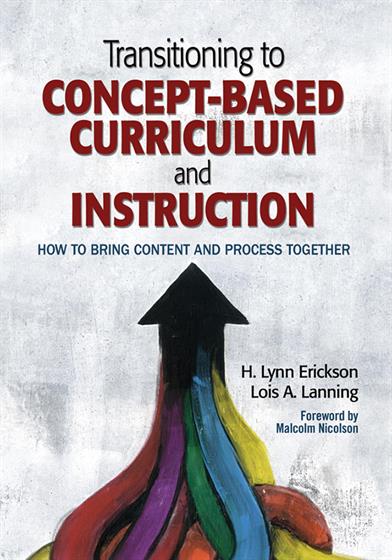
Hands-on, Practical Guidance for Educators
From math,
literacy, equity, multilingual learners, and SEL, to assessment, school counseling,
and education leadership, our books are research-based and authored by experts
on topics most relevant to what educators are facing today.
Transitioning to Concept-Based Curriculum and Instruction
Foreword by Malcolm Nicolson
Two renowned authors combine their expertise to show educators how to abandon rote teaching techniques, and embrace concept-based curriculum and its emphasis on critical thinking and analysis.
- Grade Level: PreK-12
- ISBN: 9781452290195
- Published By: Corwin
- Series: Concept-Based Curriculum and Instruction Series
- Year: 2013
- Page Count: 224
- Publication date: December 27, 2013
Price: $39.95
For Instructors
When you select 'request review copy', you will be redirected to Sage Publishing (our parent site) to process your request.
Description
A cutting-edge model for 21st century curriculum and instruction
How can you spot a thinking child? Look at the eyes: they’ll light up, signaling that transformative moment when your student has finally grasped that big idea behind critical academic content. If experiences like this are all too rare in your school, then you need a curriculum and instruction model that’s more inquiry-driven and idea-centered. Now.
H. Lynn Erickson and Lois Lanning demonstrate how, through concept-based curriculum, you can move beyond superficial coverage and lower-level skills practice to effect intellectually engaging pedagogy, where students engage in problem finding and problem solving. New insights include:
- How to design and implement concept-based curriculum and instruction across all subjects and grade levels.
- Why content and process are two different (but equally important) aspects of any effective concept-based curriculum.
- How to ensure students develop the all-important skill of synergistic thinking.
We’re all looking for the best curriculum and instruction model to meet the changing demands of the 21st century. This is it.
"With the onset of the Common Core and new national content standards, concept-based learning is now more crucial than ever. Erickson and Lanning are 'ahead of the curve' in providing teachers and curriculum leaders with rich instructional strategies to meet these challenging standards. This is an essential book for planning tomorrow’s curricula today."
Douglas Llewellyn, Educational Consultant and Author of Inquire Within, Third Edition
"Powerful teaching engages minds with powerful ideas. At its core, such transformative teaching is neither transmission of information nor practice with inert skills. Rather it is a careful choreography between a mind and an idea such that the mind comes to own the idea in a form that is true to the discipline and expansive for the learner. Erickson and Lanning teach teachers to be choreographers of learning—understanding both what makes content worth knowing and how to engage young minds with that content in ways that extend their capacities to understand it at a deeper level, use it, transfer it, and ultimately create with it."
Carol Ann Tomlinson, Ed.D., Chair of Educational Leadership, Foundations, and Policy
Curry School of Education, University of Virginia
Key features
-
Discusses the contributions and problems inherent in the traditional design model of content and skill objectives
-
Brings together Lynn Erickson’s Structure of Knowledge with Lois Lanning’s Structure of Process to give educators the full explanation of the foundations of concept-based curriculum related to both content and process
-
Provides subject-specific, annotated examples of how the structure of knowledge and structure of process can guide curriculum design in social studies, science, mathematics, language arts, world language, visual arts, and music
-
Describes the characteristics of developing concept-based teachers and students and provides a rubric of novice, emerging, and exemplary characteristics to help teachers and administrators monitor their progress
-
Explores the pedagogical shifts required to move from the traditional two-dimensional, coverage model of instruction to the more sophisticated three-dimensional concept-based model
-
Provides tools and strategies to ensure a coordinated alignment among the written curriculum, student performance data, and the ongoing support of teachers as they develop their skills to meet student needs
-
Explains how district leaders can ensure that a strong curriculum infrastructure is in place to build staff capacity
Author(s)

H. Lynn Erickson
H. Lynn Erickson, Ed.D., is an independent consultant assisting schools and districts with concept-based curriculum design and instruction. During the past 20 years Lynn has worked extensively with K-12 teachers and administrators on the design of classroom and district level curricula aligned to academic standards and national requirements. She was a consultant to the International Baccalaureate Organization for the development of the Middle Years Programme—the Next Chapter.
Lynn is the author of three best-selling books, Stirring the Head, Heart and Soul: Redefining Curriculum and Instruction, 3rd edition ©2008; Concept-based Curriculum and Instruction: Teaching Beyond the Facts, ©2002; and Transitioning to Concept-based Curriculum and Instruction: How to Bring Content and Process Together, co-authored with Dr. Lois Lanning, © 2014, Corwin Press Publishers. This publication, co-authored with Lois Lanning and Rachel French is the 2nd edition of Lynn’s popular book, Concept-based Curriculum and Instruction for the Thinking Classroom: Teaching Beyond the Facts. She also has a chapter in Robert Marzano’s book, On Excellence in Teaching, ©2010, Solution Tree Press.
Lynn is an internationally recognized presenter/consultant in the areas of concept-based curriculum design, and teaching for deep understanding. She has worked as a teacher, principal, curriculum director, adjunct professor, and educational consultant over a long career. In addition to her work in the United States, Lynn has presented and trained educators across the world in different regions and countries including Asia, Australia, South America, Canada, the United Kingdom, Finland, Germany, the Netherlands, the United Kingdom, Switzerland, Austria, China, Saudi Arabia, United Arab Emirates and Cyprus.
Lynn currently lives in Everett, Washington with her family. She and Ken have two children, and two grandsons, Trevor and Connor, who continually stir her heart and soul.

Lois A. Lanning
Lois A. Lanning, PhD, is an independent education consultant. She presents and works with districts at the international, national, and state levels in the areas of literacy and Concept- Based Curriculum design.
This book is a natural extension of her three previous best-selling books in the Corwin Press Publisher’s Concept-Based collection, including Designing a Concept-Based Curriculum for English Language Arts (2013), by Lois A. Lanning; Concept-Based Curriculum and Instruction for the Thinking Classroom (2nd ed., 2017), by H. Lynn Erickson, Lois A. Lanning, and Rachel French; and Transitioning to Concept-Based Curriculum and Instruction (2014), by H. Lynn Erickson and Lois A. Lanning.
In addition, Lois is the author of the bestselling book, Four Powerful Strategies for Struggling Readers, Grades 3-8: Small Group Instruction That Improves Comprehension, a joint publication between Corwin Press and the International Reading Association (2009), and a chapter in The Best of Corwin: Differentiated Instruction in Literacy, Math, and Science (2011), Leslie Laud, Editor.
Lois was a classroom teacher, K-12 reading consultant, special education teacher, elementary school principal, district curriculum director, adjunct professor, and finally, an assistant superintendent of schools for the last 12 years of her career in public schools. Lois is the recipient of numerous educational awards and recognitions.
Her hobbies include reading, biking, hiking, and traveling. Lois currently lives in Massachusetts with her husband. She has two children and two grandsons, whom she absolutely adores.
Table of Contents
List of Figures and Tables
Foreword by Malcolm Nicolson
Acknowledgments
About the Authors
Introduction
Purpose of the Book
Audiences
Chapter Overview
Chapter 1. Curriculum Design: From an Objectives-Based to a Concept-Based Model
A Short Retrospective, From the Authors, on Educational Swings
The Value of Know, Understand, and Able to Do in Concept-Based Models
Problems With Traditional Content Objectives
Discussion Questions
Summary
Chapter 2. Two-Dimensional Versus Three-Dimensional Curriculum Models
Contrasting the Two-Dimensional and Three-Dimensional Models
Introducing the Structures of Knowledge and Process
The Interplay of Process and Knowledge
Contrasting Instructional Descriptions
Discussion Questions
Summary
Chapter 3. The Structure of Knowledge
Understanding the Relationships in the Structure of Knowledge
How the Structure of Knowledge Guides Curriculum Design
Designing Disciplinary Curriculum Frameworks at the National, State, or Local Levels
Mathematics as a Concept-Driven Discipline
Examples of Concepts and Subject-Specific Generalizations
Discussion Questions
Summary
Chapter 4. The Structure of Process
The Structure of Process
How the Structure of Process Guides Curriculum and Instruction
Discussion Questions
Summary
Chapter 5. The Developing Concept-Based Teacher
Bridging the Gaps Between Knowing, Doing, and Understanding
Collaborative Concept-Based Lesson Planning
Common Terminology Used to Describe Quality Instruction
The Developing Concept-Based Teacher
Do The Developing Concept-Based Teacher Rubrics Have a Place in Teacher Evaluation Plans?
Discussion Questions
Summary
Chapter 6. The Developing Concept-Based Student
What About Thinking?
The Relationship Between Critical Thinking and Concept-Based Teaching and Learning
Developing Critical Thinking
The Developing Concept-Based Student
Why These Categories?
Discussion Questions
Summary
Chapter 7. What Do Teachers Need to Understand About Concept-Based Pedagogy?
The What and Why of Concept-Based Curriculum and Instruction
The How of Concept-Based Curriculum and Instruction
Four Critical Aspects of Concept-Based Pedagogy
Quality Pedagogy
Concept-Based Classrooms
Discussion Questions
Summary
Chapter 8. What Do Principals and Instructional Coaches Need to Understand? Implementing and Sustaining Concept-Based Curricular and Instructional Models in Schools
Setting the Stage for Curriculum Implementation
Staff Development
Staff Support With Accountability: Building System-Wide Synergy
The Collection and Analysis of the "Right" Data
Discussion Questions
Summary
Chapter 9. What Do District Leaders Need to Understand About Concept-Based Curriculum Designs?
District Leaders Discuss Concept-Based Curriculum and Instruction
Discussion Questions
Summary
Chapter 10. Summary and the Road Ahead
Curriculum and Instruction: The Warp
Concept-Based Learning: The Weft
The Path Forward
Discussion Questions
Resources
Resource A. Concept-Based Mathematics Unit
Resource B. Concept-Based Science Unit
Resource C. Concept-Based Art Unit
Resource D. Concept-Based World Language Unit
Resource E. Concept-Based Music Unit
Resource F. Adapted Learning Activities for Chapter 7
References
Index
Reviews
"With the onset of the Common Core and new national content standards, concept-based learning is now more crucial than ever. Erickson and Lanning are “ahead of the curve” in providing teachers and curriculum leaders with rich instructional strategies to meet these challenging standards. This is an essential book for planning tomorrow’s curricula today."Douglas Llewellyn, Educational Consultant and Author of Inquire Within, Third Edition
"Powerful teaching engages minds with powerful ideas. At its core, such transformative teaching is neither transmission of information nor practice with inert skills. Rather it is a careful choreography between a mind and an idea such that the mind comes to own the idea in a form that is true to the discipline and expansive for the learner. Erickson and Lanning teach teachers to be choreographers of learning—understanding both what makes content worth knowing and how to engage young minds with that content in ways that extend their capacities to understand it at a deep level, use it, transfer it, and ultimately create with it."Carol Ann Tomlinson, Ed.D., Chair of Educational Leadership, Foundations, and Policy
Curry School of Education, University of Virginia
"As educators we all think we understand concept-based curriculum, but those who read this text will have a comprehensive understanding of the meaning and value of concept-based curriculum. This text clearly explains concept-based teaching for the educator to use and develop a change in their teaching to effectively reach and engage students in critical thinking that will enable them to be productive citizens and lifelong learners."Mrs. Karen Creech, Loudoun County Teacher
Catoctin Elementary School, Leesburg, VA
"High school department heads take notice! You will want to read this book with your curriculum supervisor and with your teachers before you re-design your courses to align with the aspirations of the CCSS and NGSS. The curriculum model and specific examples in this book provide you with a clear guide for designing complex, intellectually stimulating curriculum while integrating the new standards."Dr. Carol Spencer, Director of Curriculum, K - 12
Addison Northwest Supervisory Union, Vergennes, Vermont
"Providing today’s students with the skills to become critical, analytical, and life-long learners is an obligation each teacher must make. The authors present a clear path to transition from fact-based learning curriculum to concept-based curriculum. They have provided us with a clear, researched-based approach to help us advocate at our school and district level to make this critical change in curriculum."Betty Rivinus, Learning Specialist / Autism Consultant
Canby School District, Canby, OR
For Instructors
When you select 'request review copy', you will be redirected to Sage Publishing (our parent site) to process your request.

